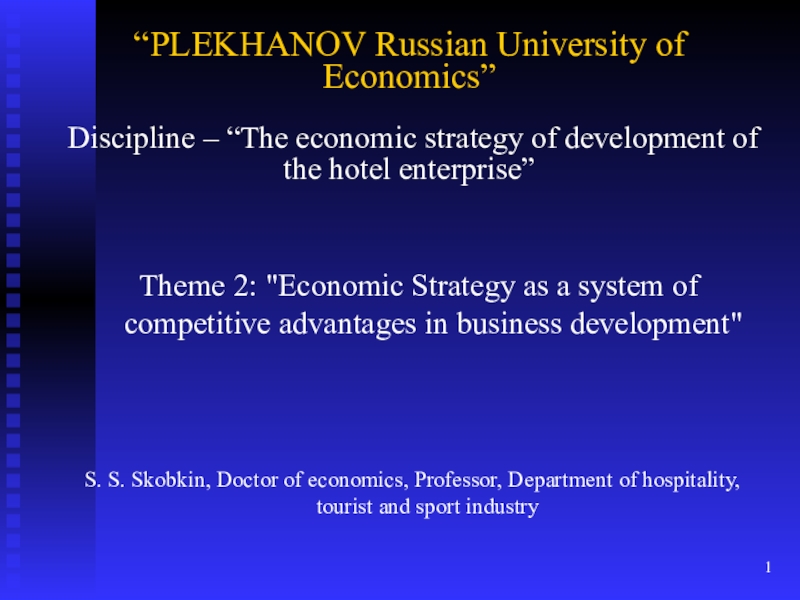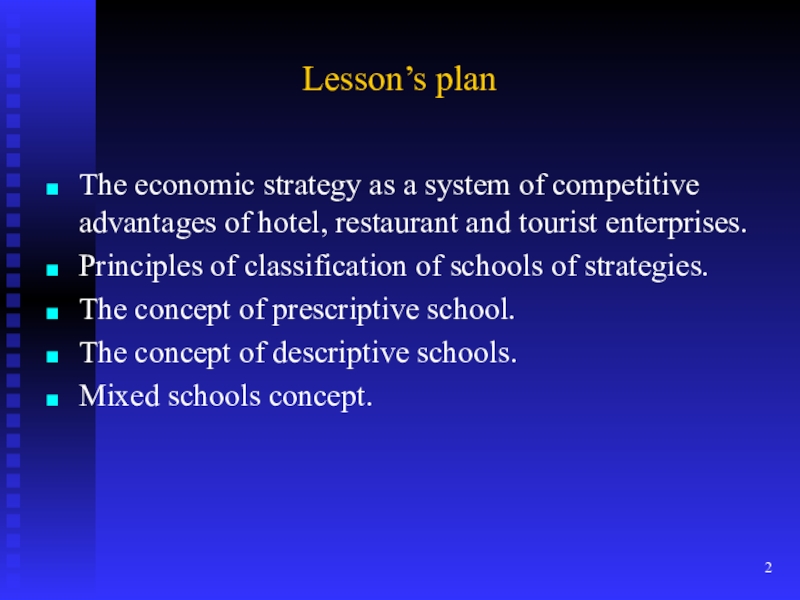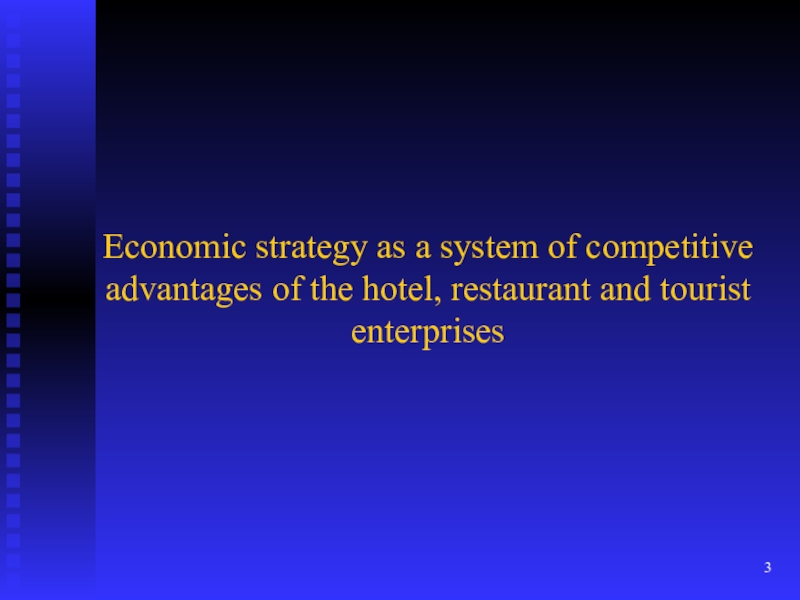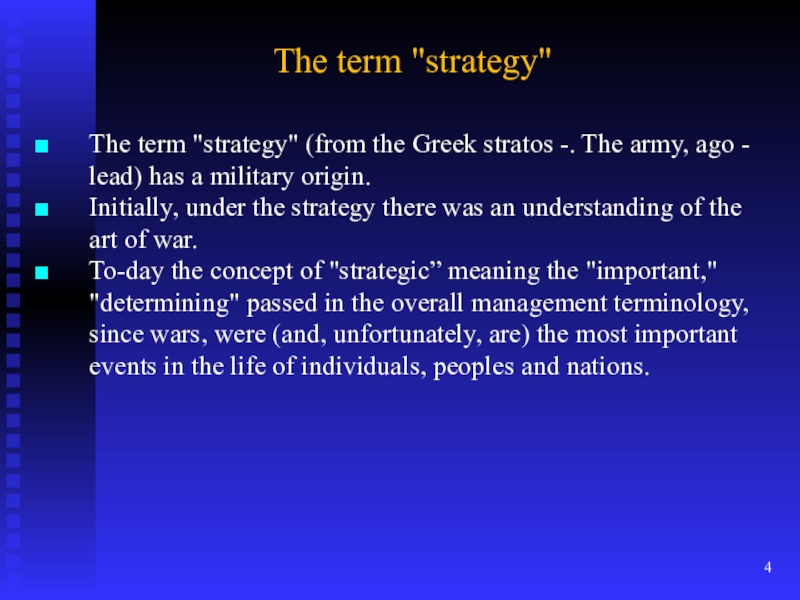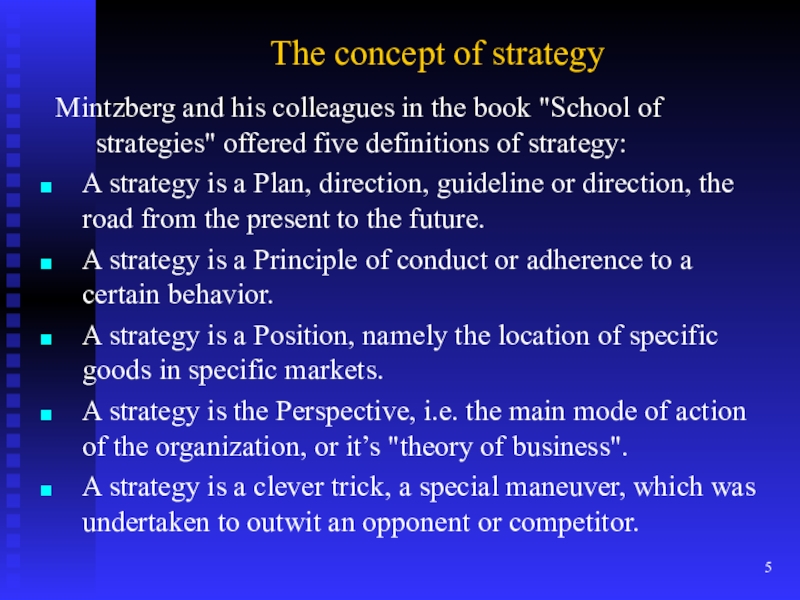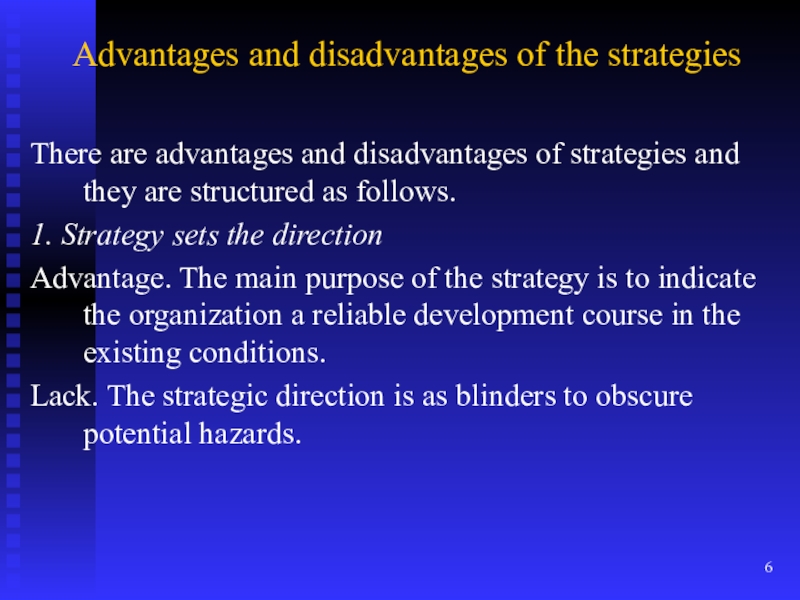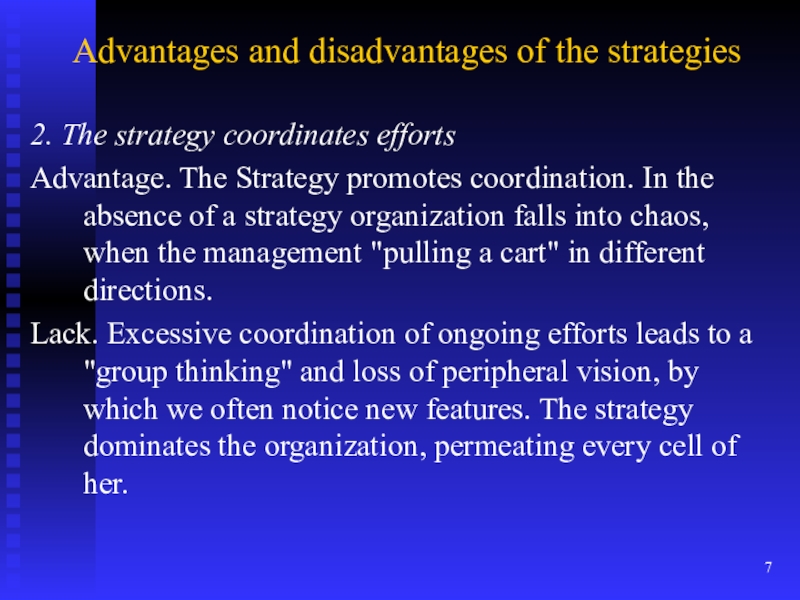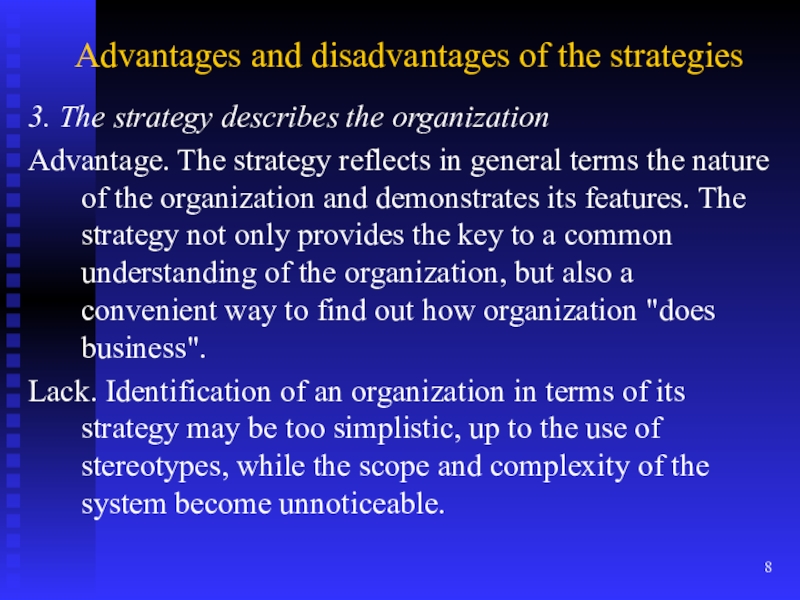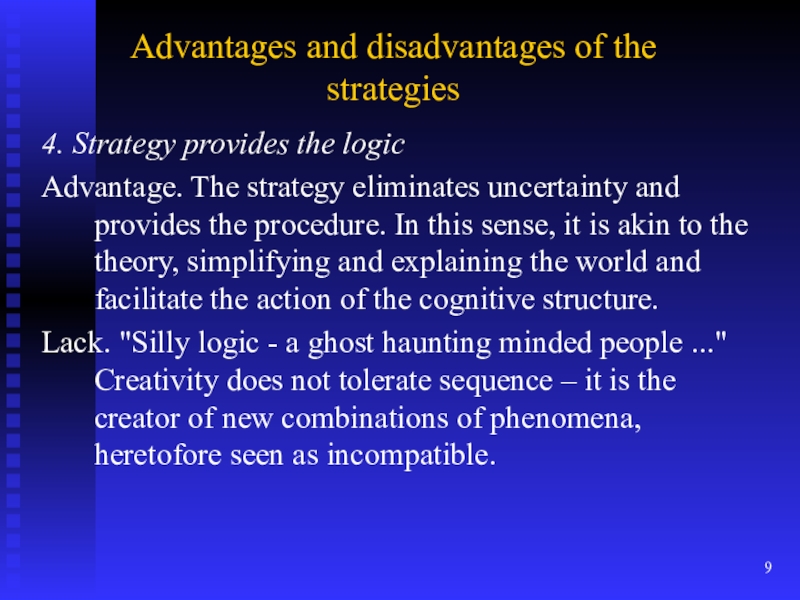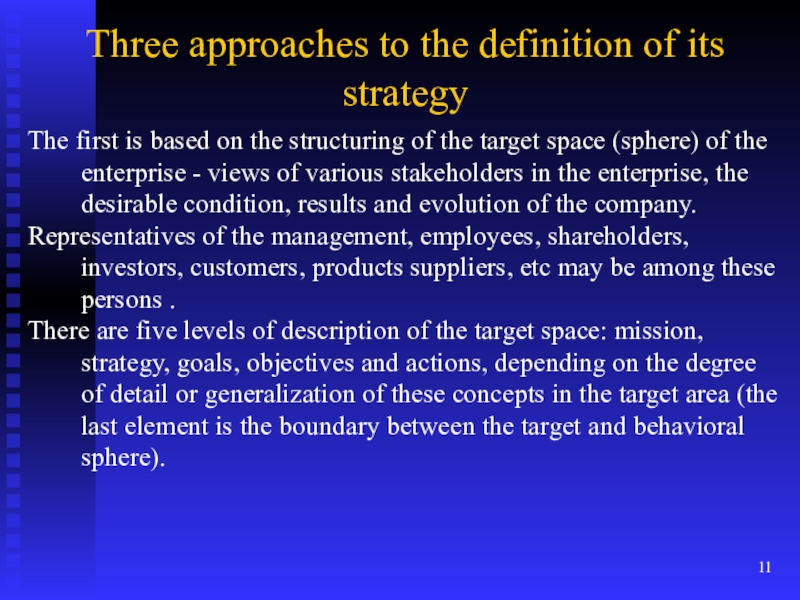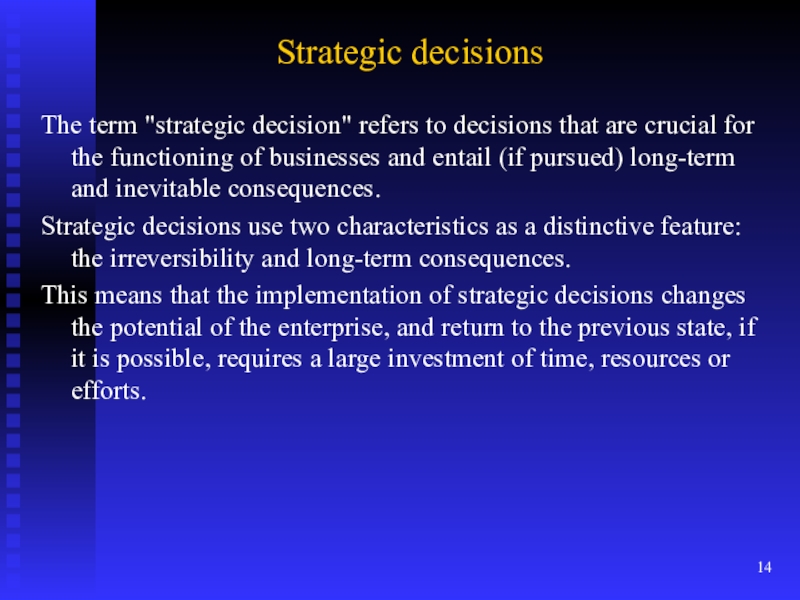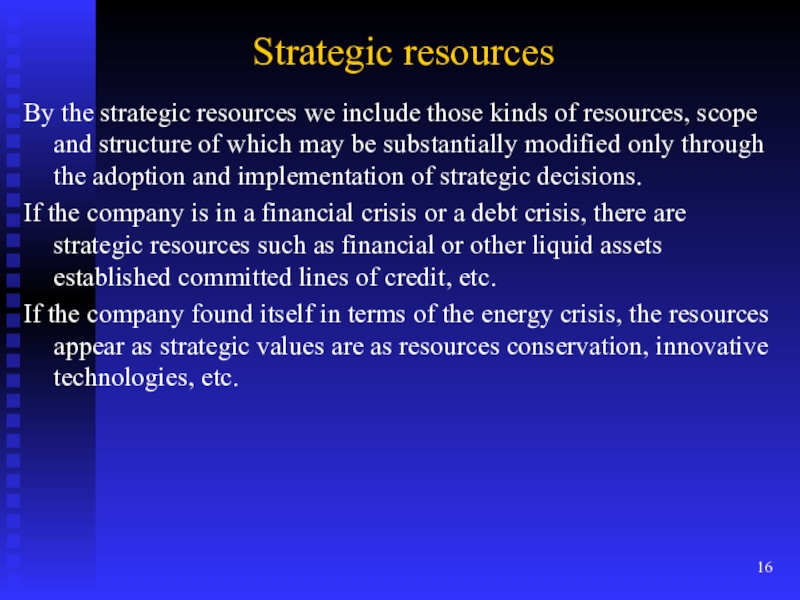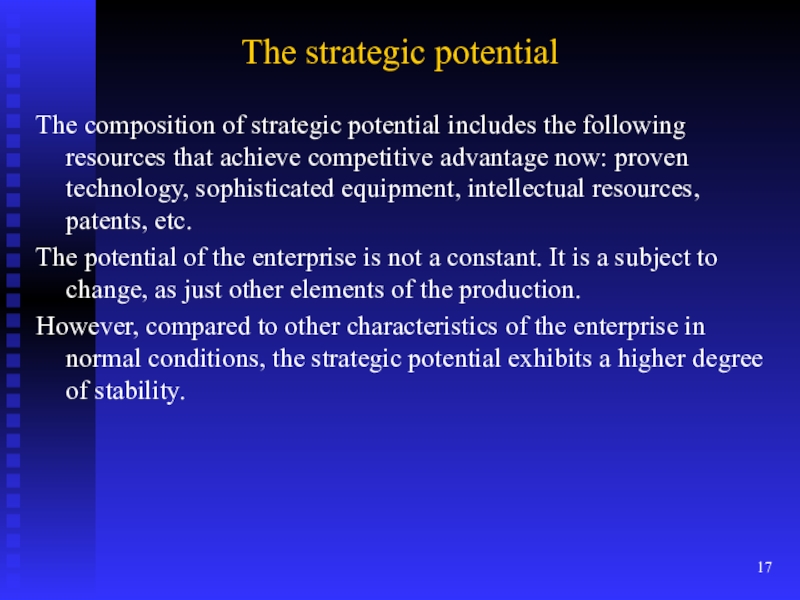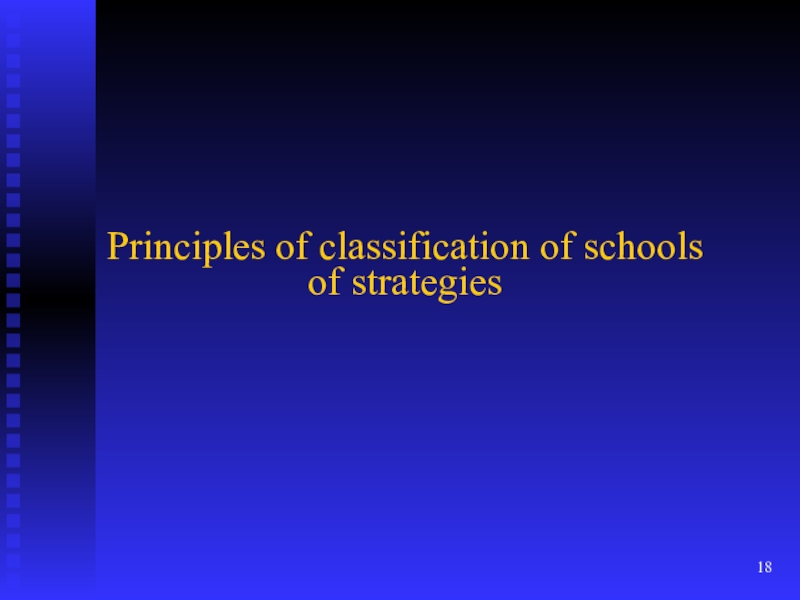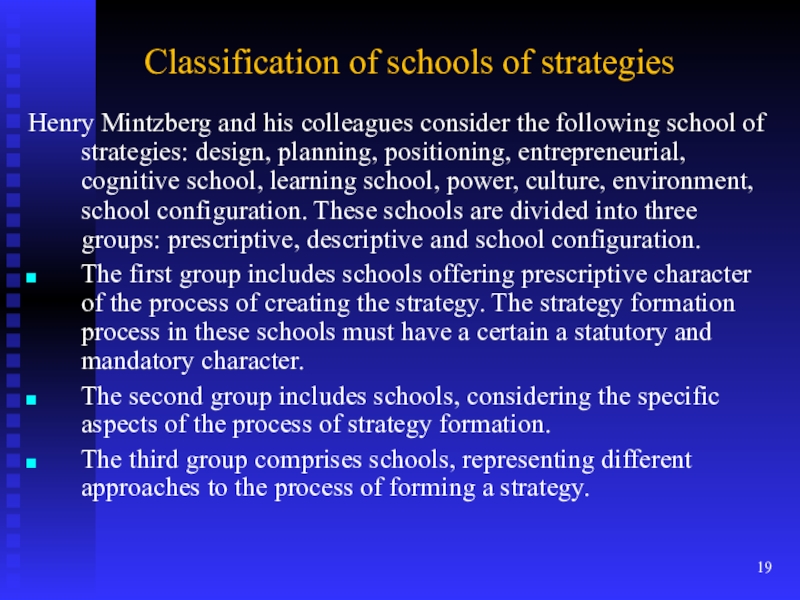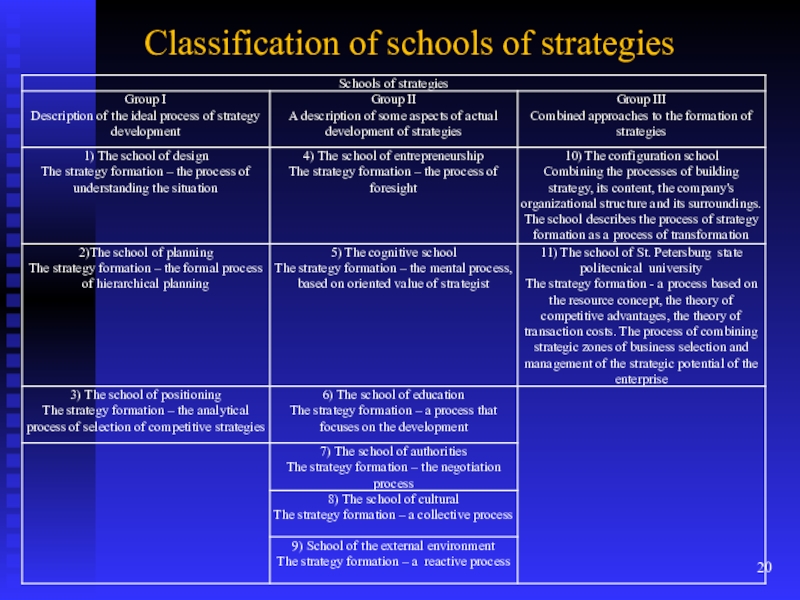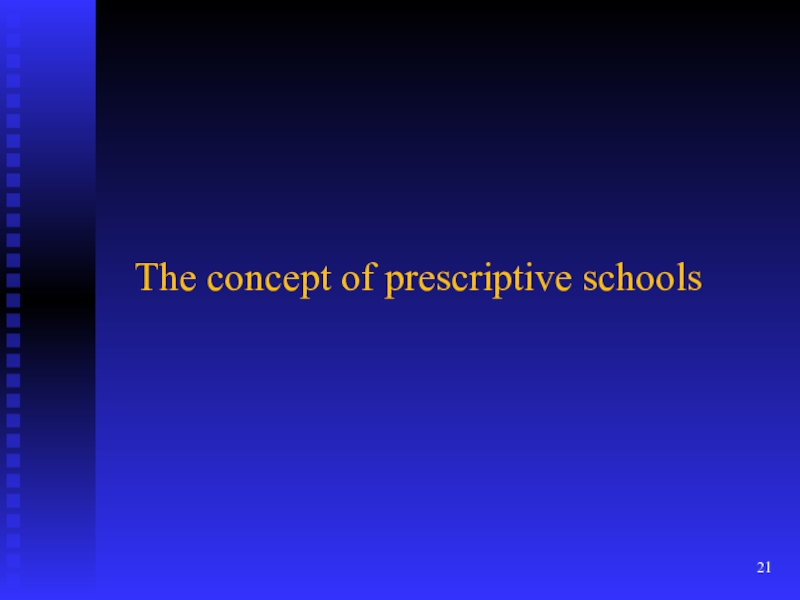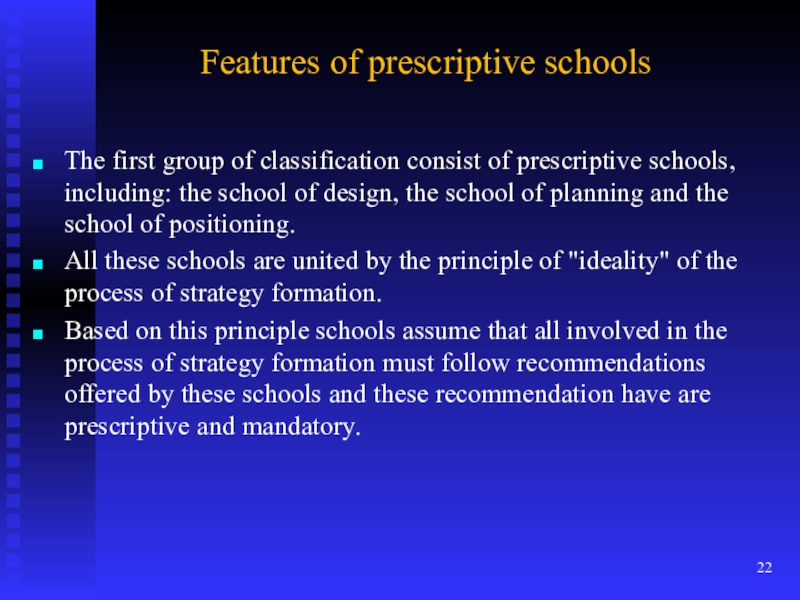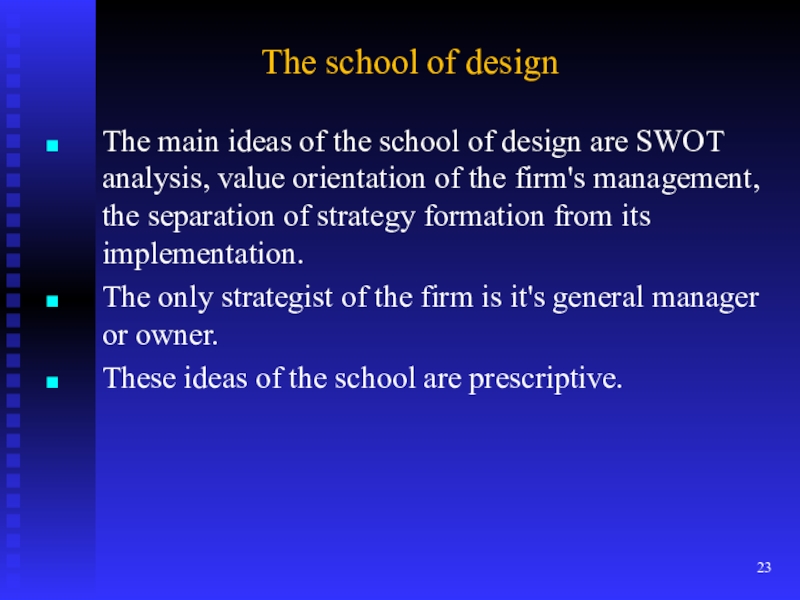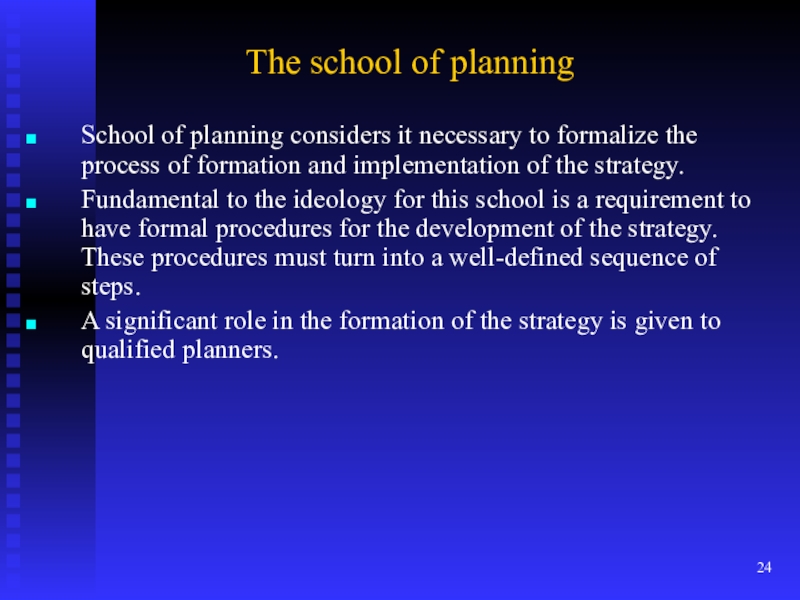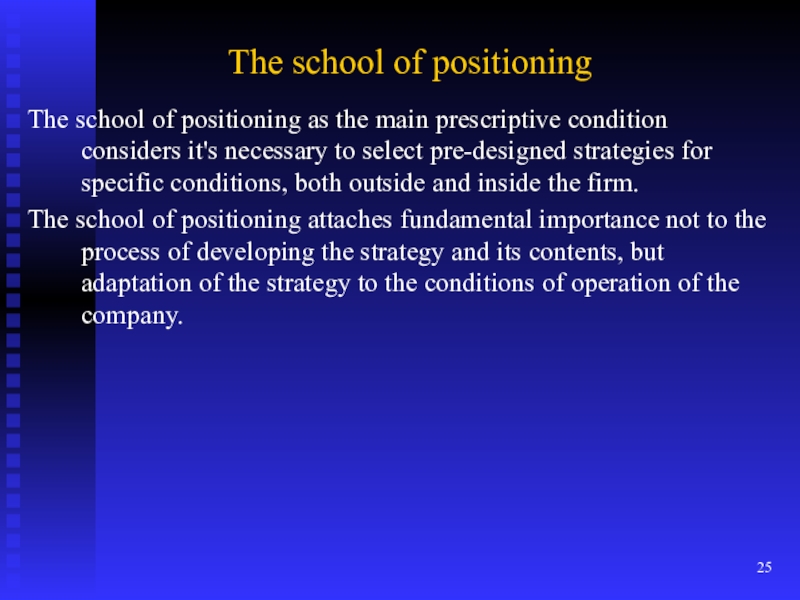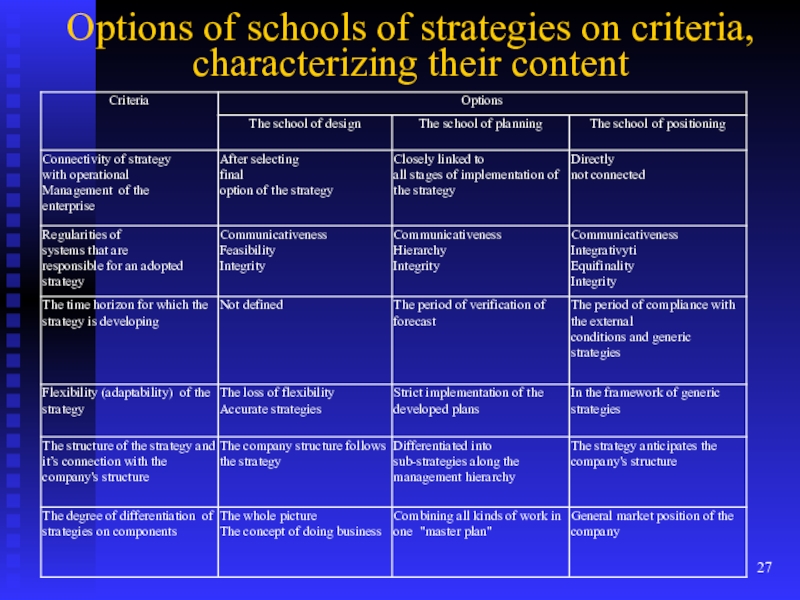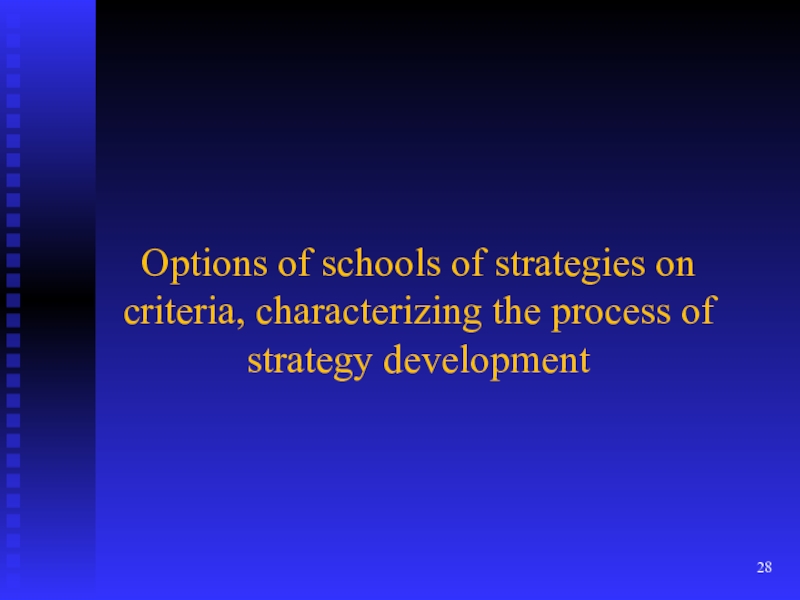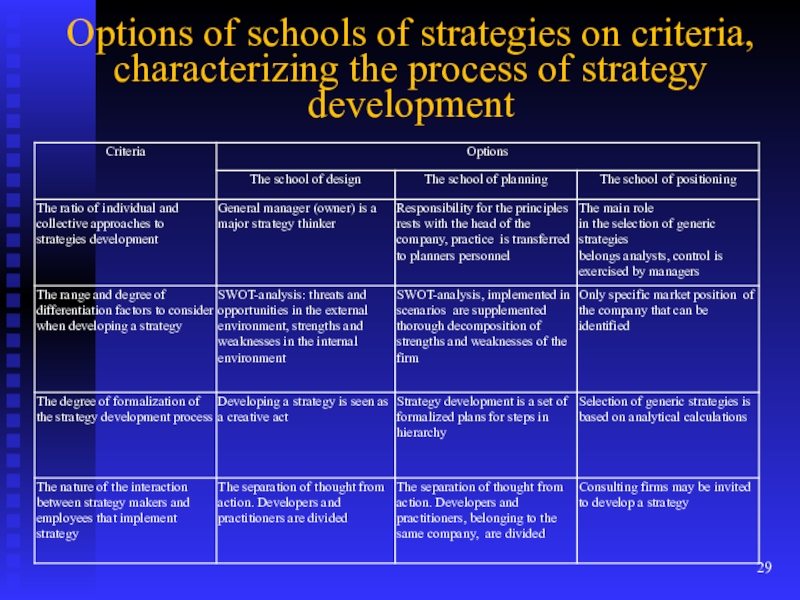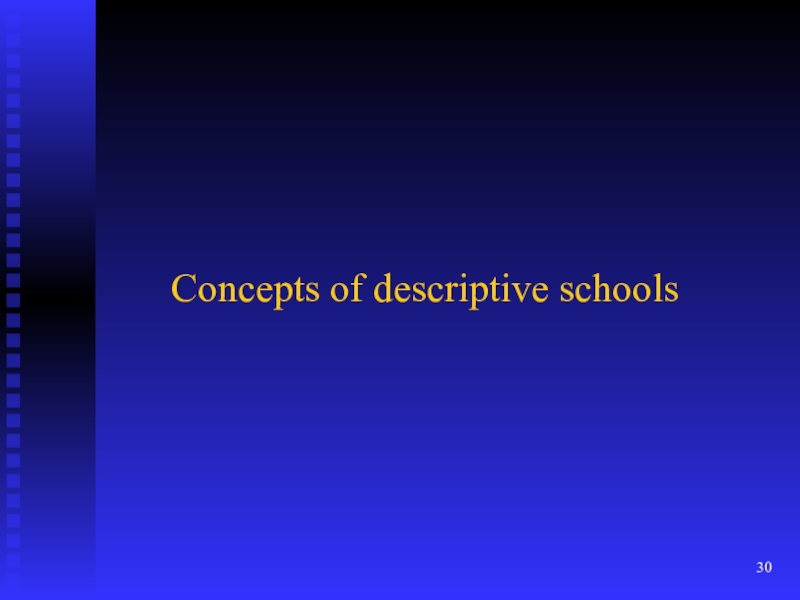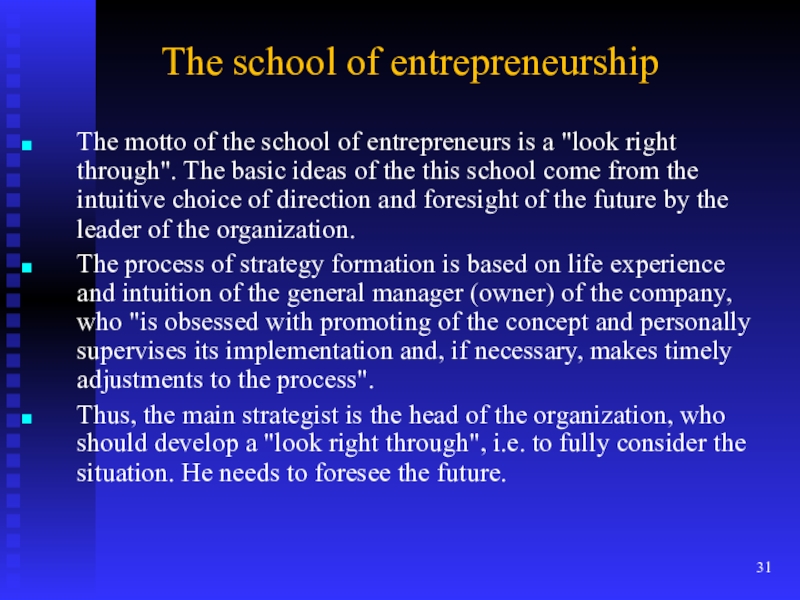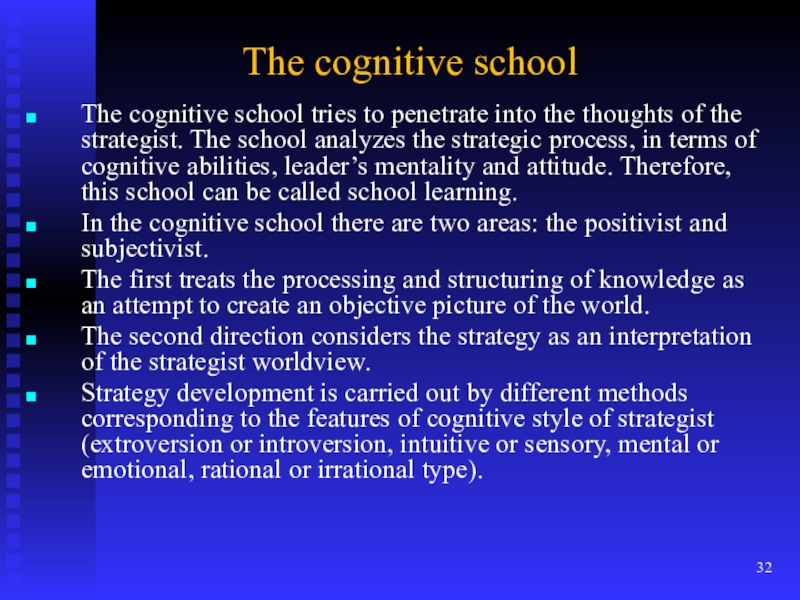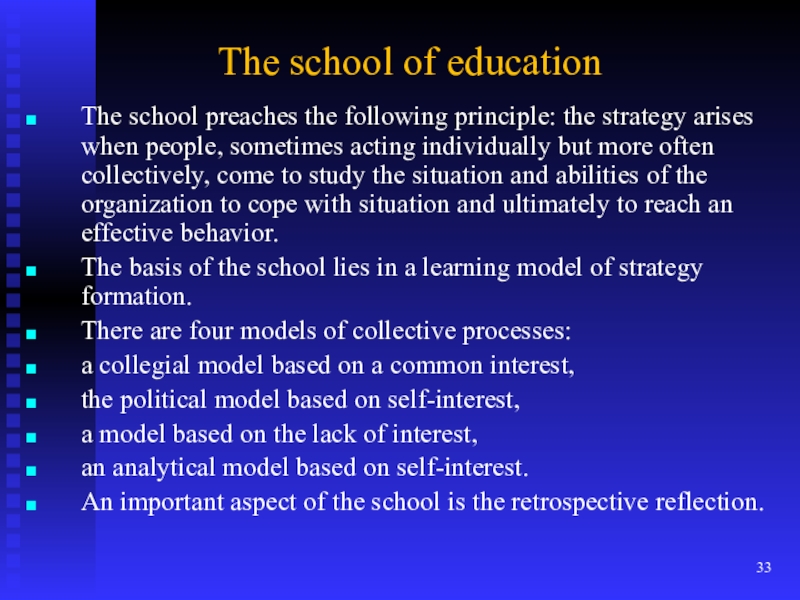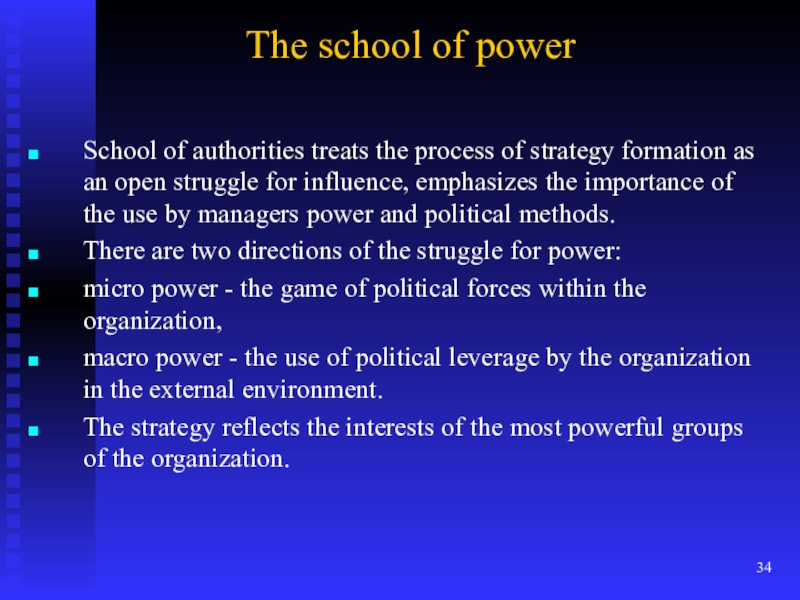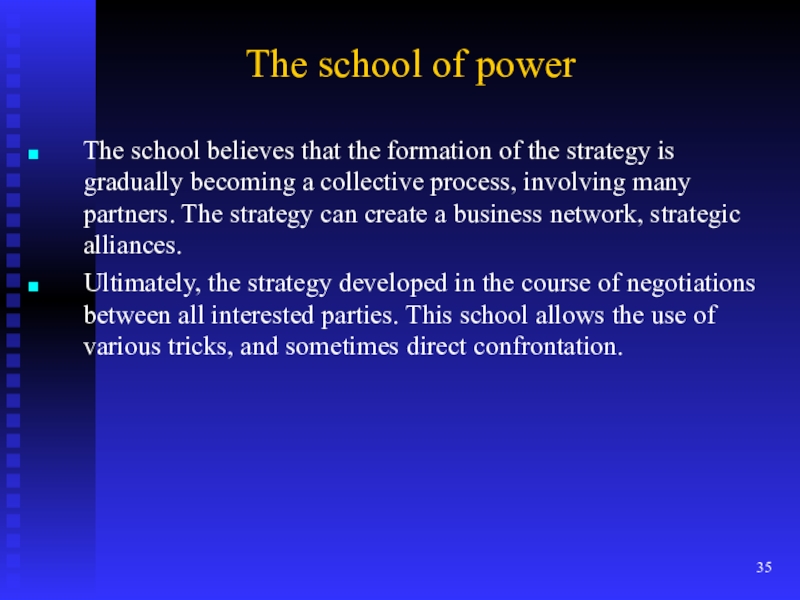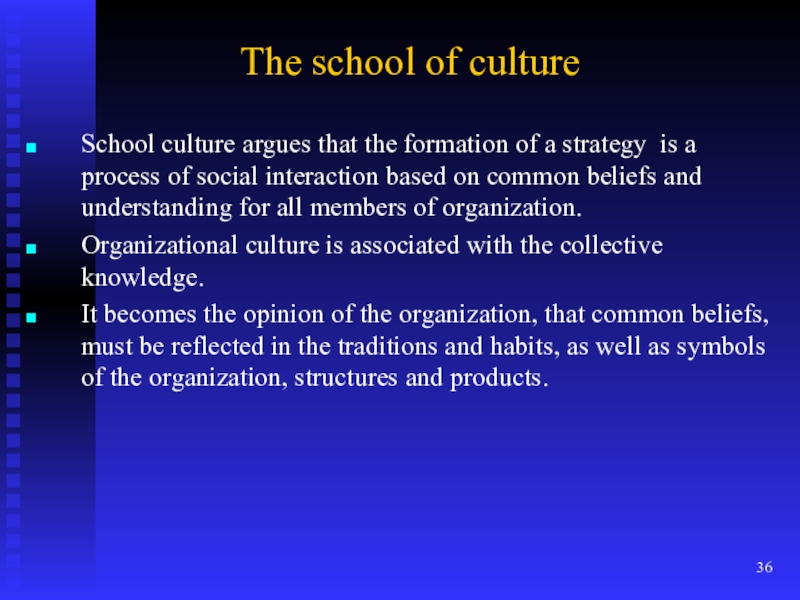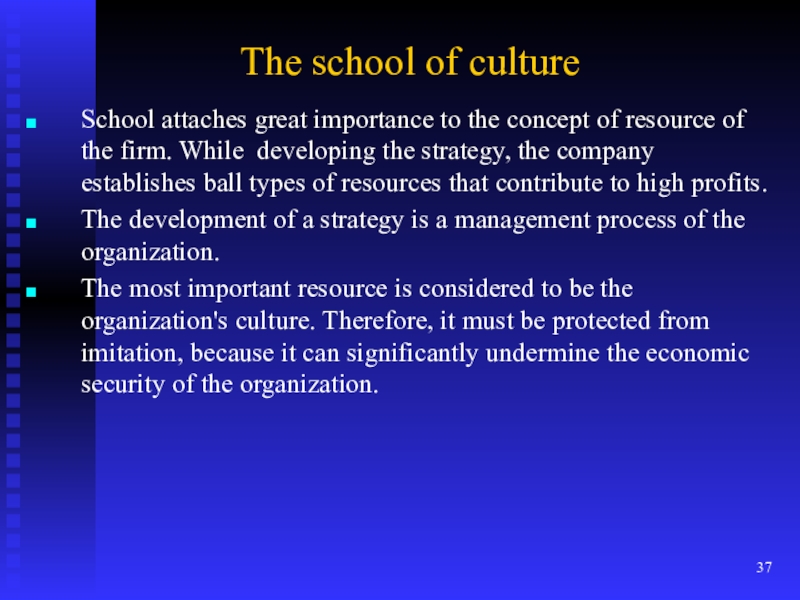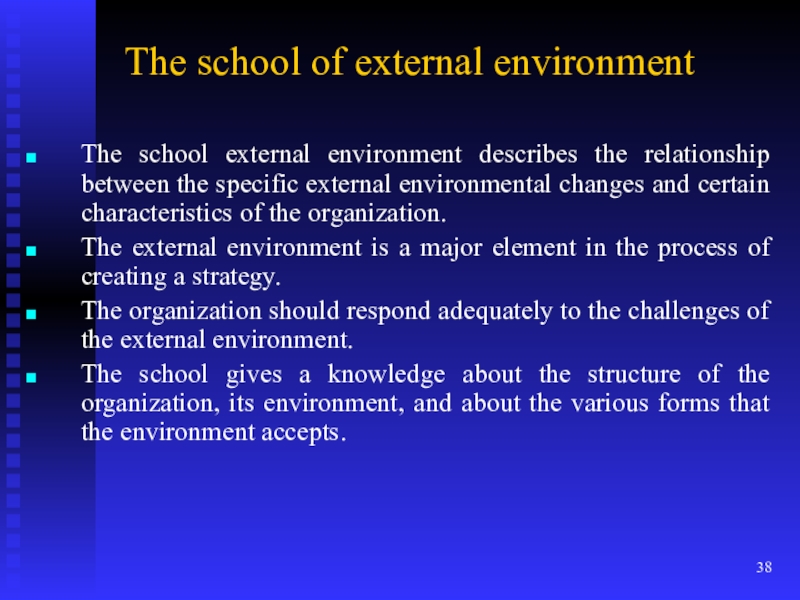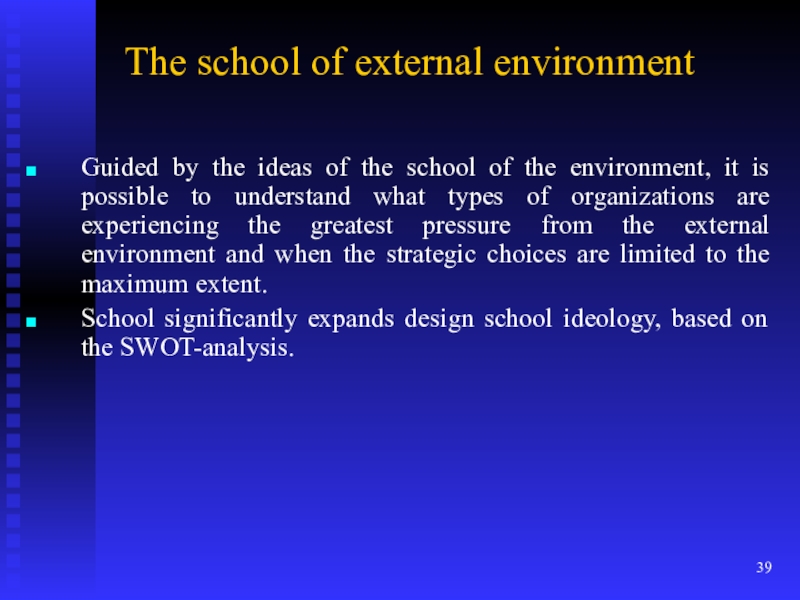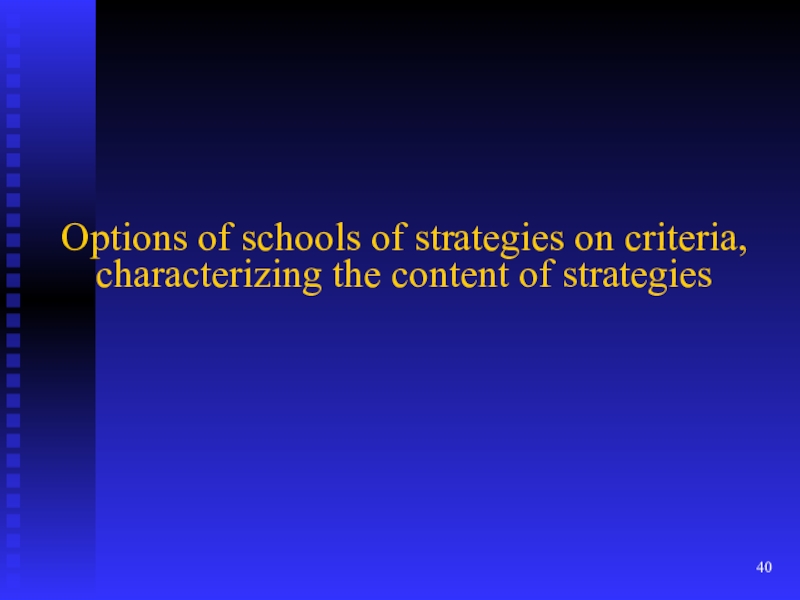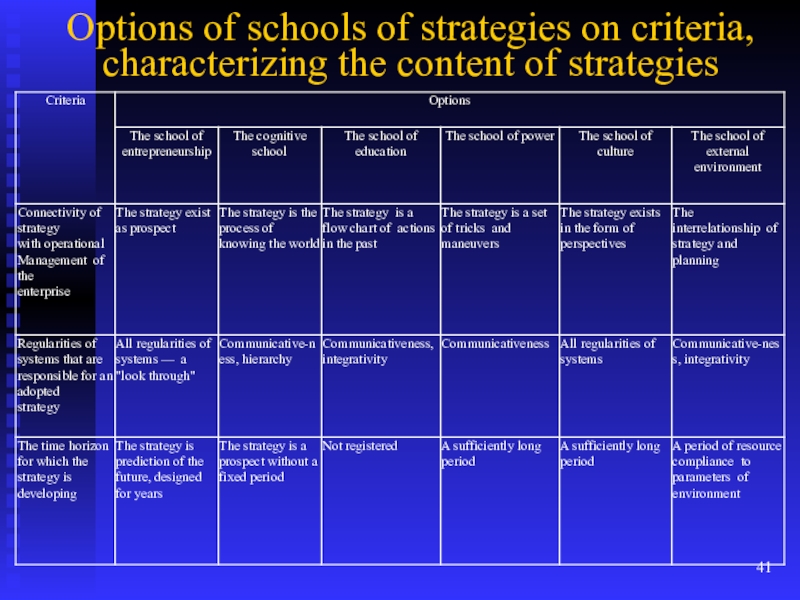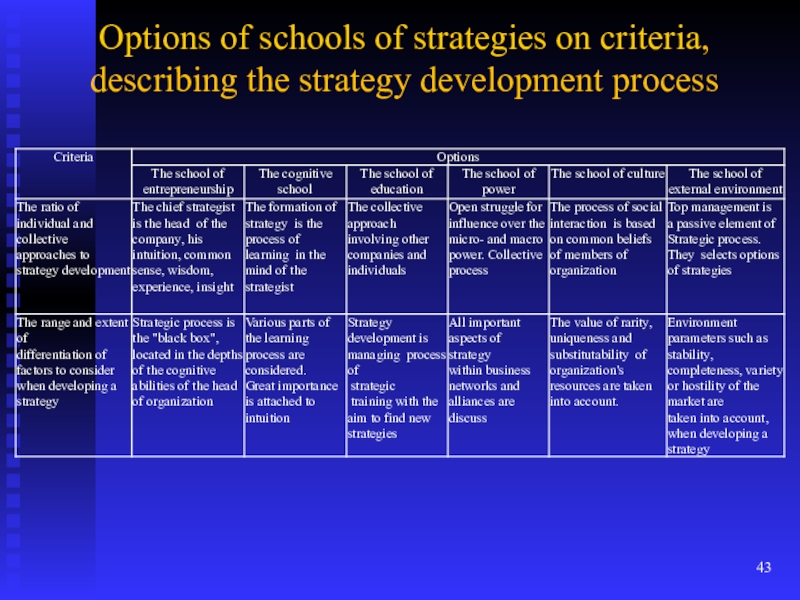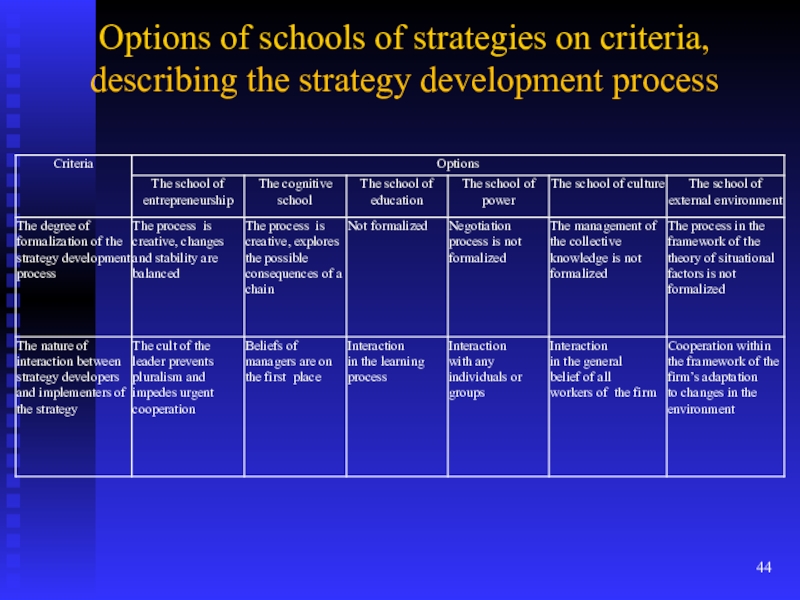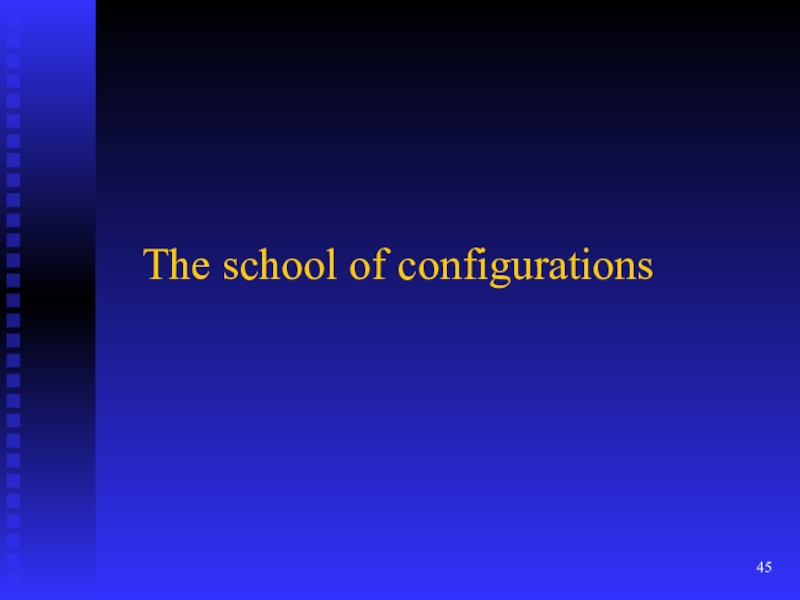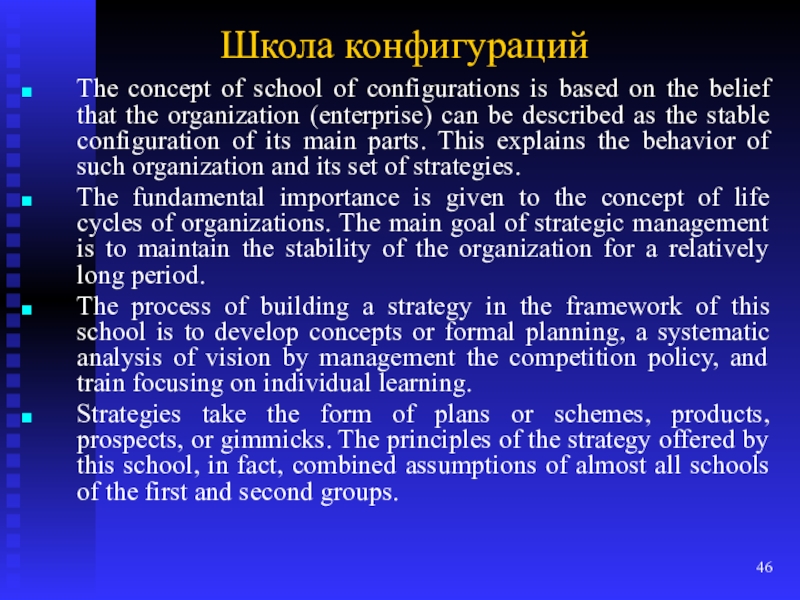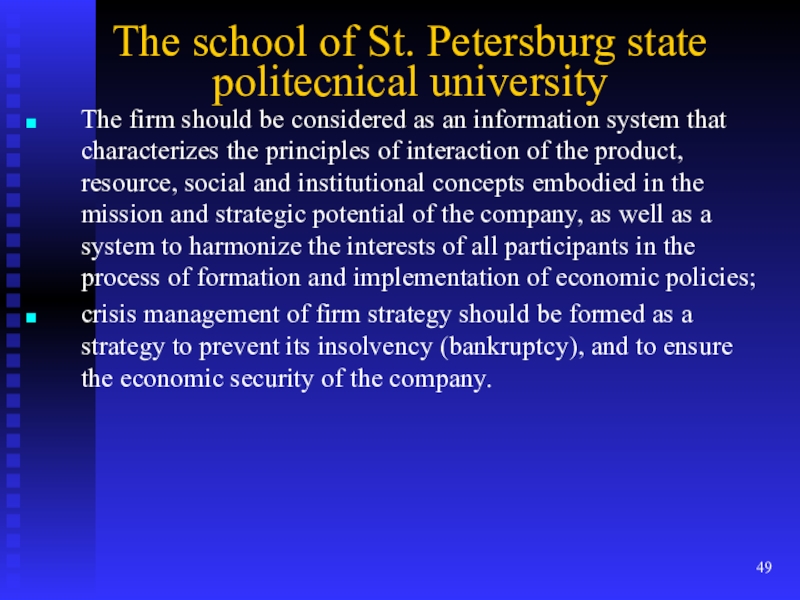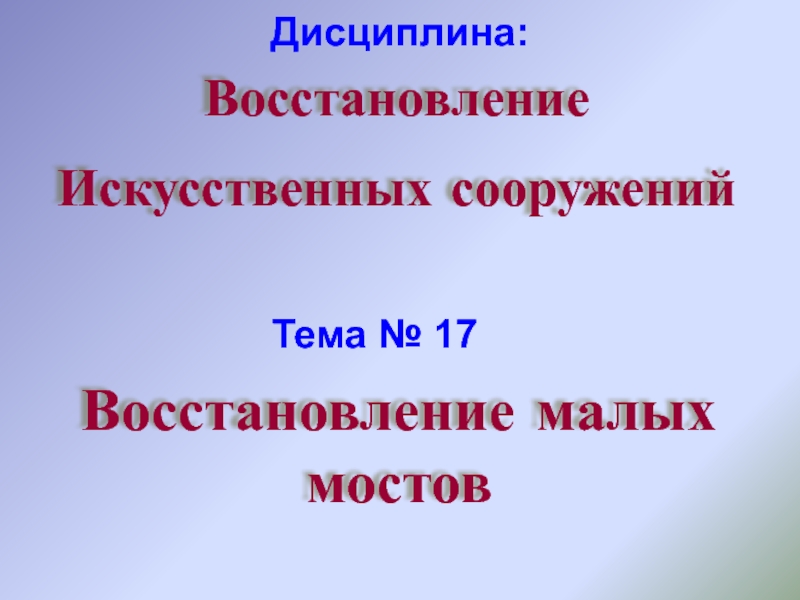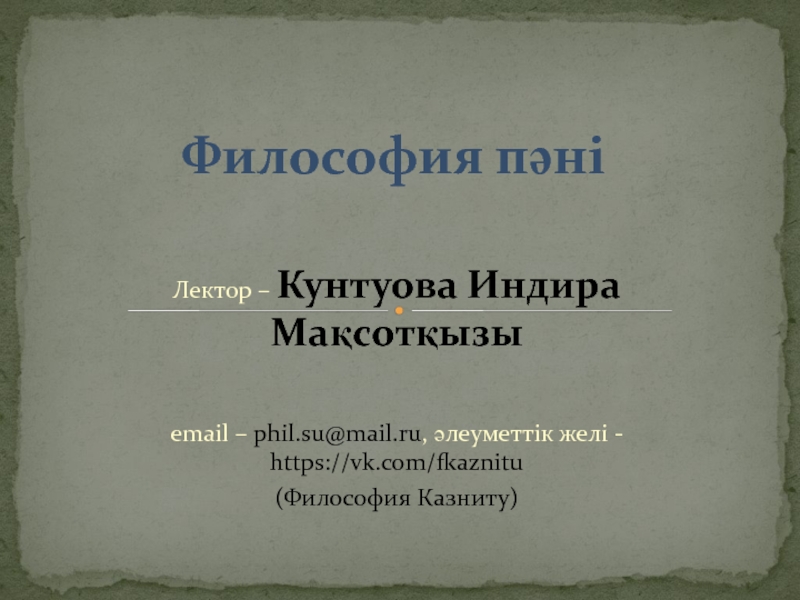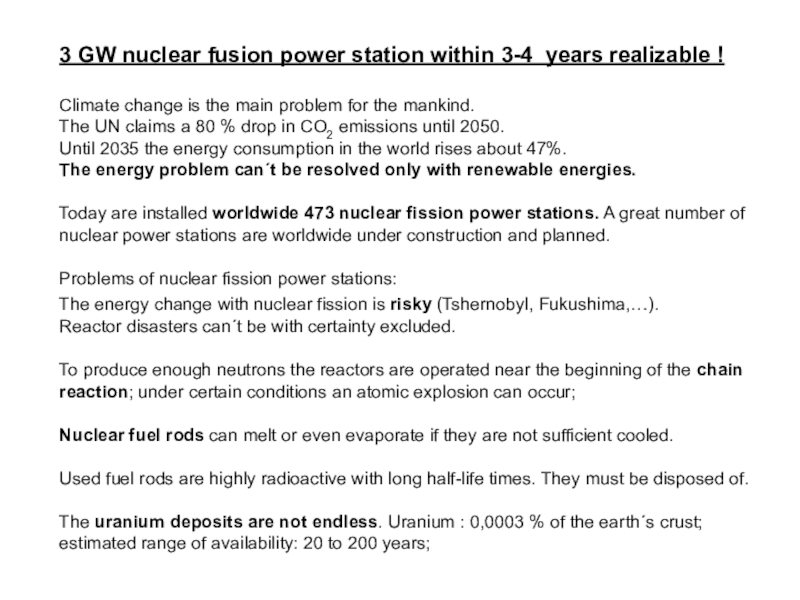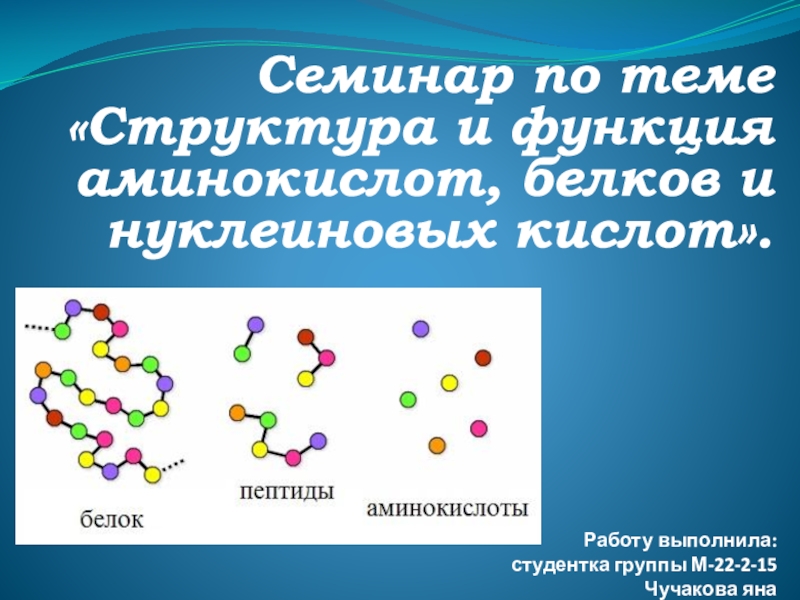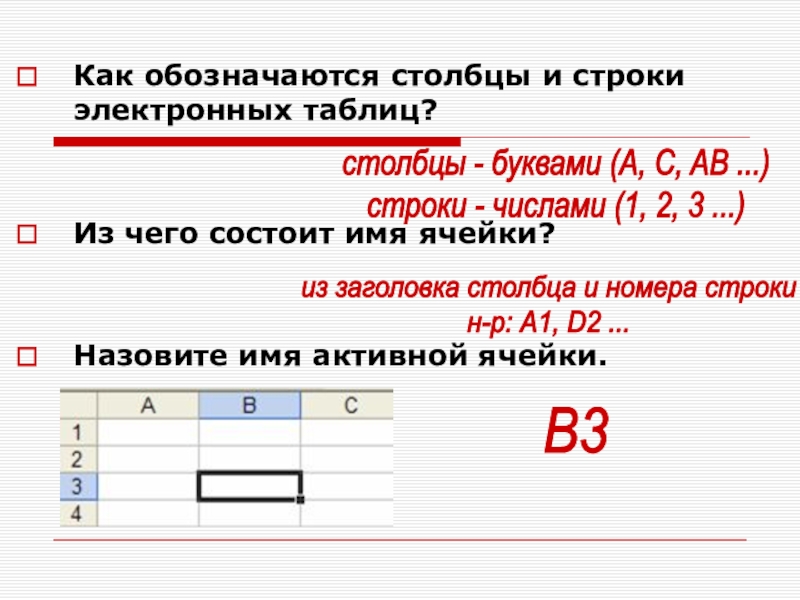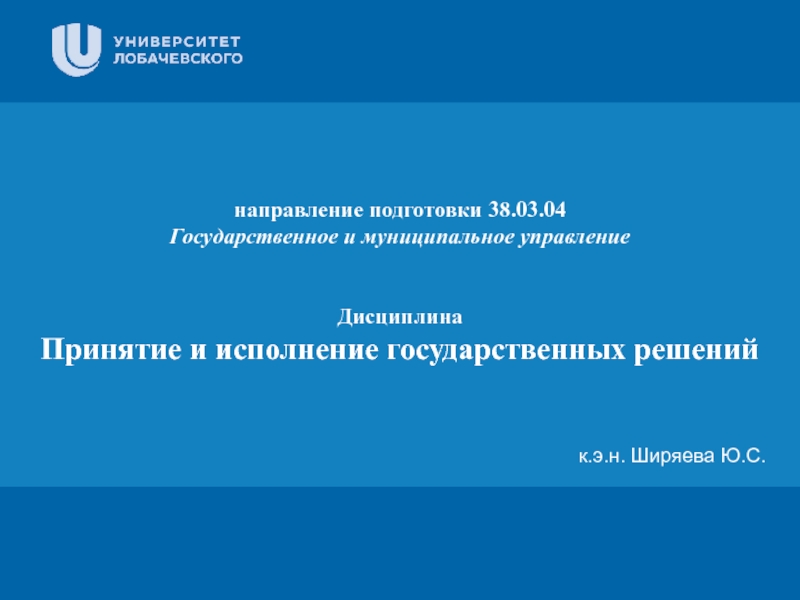Слайд 1“PLEKHANOV Russian University of Economics”
Discipline – “The economic
strategy of development of the hotel enterprise”
S. S. Skobkin,
Doctor of economics, Professor, Department of hospitality, tourist and sport industry
Theme 2: "Economic Strategy as a system of competitive advantages in business development"
Слайд 2Lesson’s plan
The economic strategy as a system of competitive advantages
of hotel, restaurant and tourist enterprises.
Principles of classification of schools
of strategies.
The concept of prescriptive school.
The concept of descriptive schools.
Mixed schools concept.
Слайд 3Economic strategy as a system of competitive advantages of the
hotel, restaurant and tourist enterprises
Слайд 4The term "strategy"
The term "strategy" (from the Greek stratos -.
The army, ago - lead) has a military origin.
Initially, under
the strategy there was an understanding of the art of war.
To-day the concept of "strategic” meaning the "important," "determining" passed in the overall management terminology, since wars, were (and, unfortunately, are) the most important events in the life of individuals, peoples and nations.
Слайд 5The concept of strategy
Mintzberg and his colleagues in the book
"School of strategies" offered five definitions of strategy:
A strategy is
a Plan, direction, guideline or direction, the road from the present to the future.
A strategy is a Principle of conduct or adherence to a certain behavior.
A strategy is a Position, namely the location of specific goods in specific markets.
A strategy is the Perspective, i.e. the main mode of action of the organization, or it’s "theory of business".
A strategy is a clever trick, a special maneuver, which was undertaken to outwit an opponent or competitor.
Слайд 6Advantages and disadvantages of the strategies
There are advantages and disadvantages
of strategies and they are structured as follows.
1. Strategy sets
the direction
Advantage. The main purpose of the strategy is to indicate the organization a reliable development course in the existing conditions.
Lack. The strategic direction is as blinders to obscure potential hazards.
Слайд 7Advantages and disadvantages of the strategies
2. The strategy coordinates efforts
Advantage.
The Strategy promotes coordination. In the absence of a strategy
organization falls into chaos, when the management "pulling a cart" in different directions.
Lack. Excessive coordination of ongoing efforts leads to a "group thinking" and loss of peripheral vision, by which we often notice new features. The strategy dominates the organization, permeating every cell of her.
Слайд 8Advantages and disadvantages of the strategies
3. The strategy describes the
organization
Advantage. The strategy reflects in general terms the nature of
the organization and demonstrates its features. The strategy not only provides the key to a common understanding of the organization, but also a convenient way to find out how organization "does business".
Lack. Identification of an organization in terms of its strategy may be too simplistic, up to the use of stereotypes, while the scope and complexity of the system become unnoticeable.
Слайд 9Advantages and disadvantages of the strategies
4. Strategy provides the logic
Advantage.
The strategy eliminates uncertainty and provides the procedure. In this
sense, it is akin to the theory, simplifying and explaining the world and facilitate the action of the cognitive structure.
Lack. "Silly logic - a ghost haunting minded people ..." Creativity does not tolerate sequence – it is the creator of new combinations of phenomena, heretofore seen as incompatible.
Слайд 10The concept of strategy by I. Ansoff
A more common definition
of the term "strategy" is defined by Igor Ansoff:
“Strategy
- a set of rules and techniques that achieve the fundamental objectives of the development of a system”.
Economic management strategy or economic strategy, therefore elaborates:
a) the rules and methods to ensure cost-effective achievement of the strategic objectives;
b) the rules and methods of achieving the strategic goals based on excitation of the interest of all participants in the process of development and implementation of strategic programs in the effective attainment of these objectives.
Слайд 11Three approaches to the definition of its strategy
The first is
based on the structuring of the target space (sphere) of
the enterprise - views of various stakeholders in the enterprise, the desirable condition, results and evolution of the company.
Representatives of the management, employees, shareholders, investors, customers, products suppliers, etc may be among these persons .
There are five levels of description of the target space: mission, strategy, goals, objectives and actions, depending on the degree of detail or generalization of these concepts in the target area (the last element is the boundary between the target and behavioral sphere).
Слайд 12Three approaches to the definition of its strategy
The second approach
to the definition of strategy is based on a synthesis
of the strategy on the basis of certain policy decisions.
The strategy is defined as an integrated set of interrelated strategic decisions, sufficient to describe the key activities of the company.
Communication with the mission of the strategy is not emphasized and focused on completeness and consistency of the system of strategic decisions.
The third approach is represented by various combined versions.
Слайд 13Three approaches to the definition of its strategy
Advantages of the
first approach are associated with a "embeddedness" of the strategy
into the target area.
Advantages of the second approach are more closely related to decisions to implement strategies.
Ultimately, the content of the strategy should be the same at any approach, if implemented with sufficient consistency.
Слайд 14Strategic decisions
The term "strategic decision" refers to decisions that are
crucial for the functioning of businesses and entail (if pursued)
long-term and inevitable consequences.
Strategic decisions use two characteristics as a distinctive feature: the irreversibility and long-term consequences.
This means that the implementation of strategic decisions changes the potential of the enterprise, and return to the previous state, if it is possible, requires a large investment of time, resources or efforts.
Слайд 15The strategic implications
"The strategic implications" can have very different decisions
about the range and volume of production, relations with suppliers
and customers, social development, remuneration, and other areas of the company.
The adoption of non-strategic, operational decisions without relying on a strategic installation deprives operational decisions the validity and consistency.
Слайд 16Strategic resources
By the strategic resources we include those kinds of
resources, scope and structure of which may be substantially modified
only through the adoption and implementation of strategic decisions.
If the company is in a financial crisis or a debt crisis, there are strategic resources such as financial or other liquid assets established committed lines of credit, etc.
If the company found itself in terms of the energy crisis, the resources appear as strategic values are as resources conservation, innovative technologies, etc.
Слайд 17The strategic potential
The composition of strategic potential includes the following
resources that achieve competitive advantage now: proven technology, sophisticated equipment,
intellectual resources, patents, etc.
The potential of the enterprise is not a constant. It is a subject to change, as just other elements of the production.
However, compared to other characteristics of the enterprise in normal conditions, the strategic potential exhibits a higher degree of stability.
Слайд 18Principles of classification of schools of strategies
Слайд 19Classification of schools of strategies
Henry Mintzberg and his colleagues consider
the following school of strategies: design, planning, positioning, entrepreneurial, cognitive
school, learning school, power, culture, environment, school configuration. These schools are divided into three groups: prescriptive, descriptive and school configuration.
The first group includes schools offering prescriptive character of the process of creating the strategy. The strategy formation process in these schools must have a certain a statutory and mandatory character.
The second group includes schools, considering the specific aspects of the process of strategy formation.
The third group comprises schools, representing different approaches to the process of forming a strategy.
Слайд 20Classification of schools of strategies
Слайд 21The concept of prescriptive schools
Слайд 22Features of prescriptive schools
The first group of classification consist of
prescriptive schools, including: the school of design, the school of
planning and the school of positioning.
All these schools are united by the principle of "ideality" of the process of strategy formation.
Based on this principle schools assume that all involved in the process of strategy formation must follow recommendations offered by these schools and these recommendation have are prescriptive and mandatory.
Слайд 23The school of design
The main ideas of the school of
design are SWOT analysis, value orientation of the firm's management,
the separation of strategy formation from its implementation.
The only strategist of the firm is it's general manager or owner.
These ideas of the school are prescriptive.
Слайд 24The school of planning
School of planning considers it necessary to
formalize the process of formation and implementation of the strategy.
Fundamental
to the ideology for this school is a requirement to have formal procedures for the development of the strategy. These procedures must turn into a well-defined sequence of steps.
A significant role in the formation of the strategy is given to qualified planners.
Слайд 25The school of positioning
The school of positioning as the main
prescriptive condition considers it's necessary to select pre-designed strategies for
specific conditions, both outside and inside the firm.
The school of positioning attaches fundamental importance not to the process of developing the strategy and its contents, but adaptation of the strategy to the conditions of operation of the company.
Слайд 26Options of schools of strategies on criteria, characterizing their content
Слайд 27Options of schools of strategies on criteria, characterizing their content
Слайд 28Options of schools of strategies on criteria, characterizing the process
of strategy development
Слайд 29Options of schools of strategies on criteria, characterizing the process
of strategy development
Слайд 31The school of entrepreneurship
The motto of the school of entrepreneurs
is a "look right through". The basic ideas of the
this school come from the intuitive choice of direction and foresight of the future by the leader of the organization.
The process of strategy formation is based on life experience and intuition of the general manager (owner) of the company, who "is obsessed with promoting of the concept and personally supervises its implementation and, if necessary, makes timely adjustments to the process".
Thus, the main strategist is the head of the organization, who should develop a "look right through", i.e. to fully consider the situation. He needs to foresee the future.
Слайд 32The cognitive school
The cognitive school tries to penetrate into the
thoughts of the strategist. The school analyzes the strategic process,
in terms of cognitive abilities, leader’s mentality and attitude. Therefore, this school can be called school learning.
In the cognitive school there are two areas: the positivist and subjectivist.
The first treats the processing and structuring of knowledge as an attempt to create an objective picture of the world.
The second direction considers the strategy as an interpretation of the strategist worldview.
Strategy development is carried out by different methods corresponding to the features of cognitive style of strategist (extroversion or introversion, intuitive or sensory, mental or emotional, rational or irrational type).
Слайд 33The school of education
The school preaches the following principle: the
strategy arises when people, sometimes acting individually but more often
collectively, come to study the situation and abilities of the organization to cope with situation and ultimately to reach an effective behavior.
The basis of the school lies in a learning model of strategy formation.
There are four models of collective processes:
a collegial model based on a common interest,
the political model based on self-interest,
a model based on the lack of interest,
an analytical model based on self-interest.
An important aspect of the school is the retrospective reflection.
Слайд 34The school of power
School of authorities treats the process of
strategy formation as an open struggle for influence, emphasizes the
importance of the use by managers power and political methods.
There are two directions of the struggle for power:
micro power - the game of political forces within the organization,
macro power - the use of political leverage by the organization in the external environment.
The strategy reflects the interests of the most powerful groups of the organization.
Слайд 35The school of power
The school believes that the formation of
the strategy is gradually becoming a collective process, involving many
partners. The strategy can create a business network, strategic alliances.
Ultimately, the strategy developed in the course of negotiations between all interested parties. This school allows the use of various tricks, and sometimes direct confrontation.
Слайд 36The school of culture
School culture argues that the formation of
a strategy is a process of social interaction based on
common beliefs and understanding for all members of organization.
Organizational culture is associated with the collective knowledge.
It becomes the opinion of the organization, that common beliefs, must be reflected in the traditions and habits, as well as symbols of the organization, structures and products.
Слайд 37The school of culture
School attaches great importance to the concept
of resource of the firm. While developing the strategy, the
company establishes ball types of resources that contribute to high profits.
The development of a strategy is a management process of the organization.
The most important resource is considered to be the organization's culture. Therefore, it must be protected from imitation, because it can significantly undermine the economic security of the organization.
Слайд 38The school of external environment
The school external environment describes the
relationship between the specific external environmental changes and certain characteristics
of the organization.
The external environment is a major element in the process of creating a strategy.
The organization should respond adequately to the challenges of the external environment.
The school gives a knowledge about the structure of the organization, its environment, and about the various forms that the environment accepts.
Слайд 39The school of external environment
Guided by the ideas of the
school of the environment, it is possible to understand what
types of organizations are experiencing the greatest pressure from the external environment and when the strategic choices are limited to the maximum extent.
School significantly expands design school ideology, based on the SWOT-analysis.
Слайд 40Options of schools of strategies on criteria, characterizing the content
of strategies
Слайд 41Options of schools of strategies on criteria, characterizing the content
of strategies
Слайд 42Options of schools of strategies on criteria, characterizing the content
of strategies
Слайд 43Options of schools of strategies on criteria, describing the strategy
development process
Слайд 44Options of schools of strategies on criteria, describing the strategy
development process
Слайд 46Школа конфигураций
The concept of school of configurations is based on
the belief that the organization (enterprise) can be described as
the stable configuration of its main parts. This explains the behavior of such organization and its set of strategies.
The fundamental importance is given to the concept of life cycles of organizations. The main goal of strategic management is to maintain the stability of the organization for a relatively long period.
The process of building a strategy in the framework of this school is to develop concepts or formal planning, a systematic analysis of vision by management the competition policy, and train focusing on individual learning.
Strategies take the form of plans or schemes, products, prospects, or gimmicks. The principles of the strategy offered by this school, in fact, combined assumptions of almost all schools of the first and second groups.
Слайд 47The school of St. Petersburg state politecnical university
The concept of
this school suggests:
definition of economic strategy and the process of
its development and implementation as a system of interrelated rules and techniques that ensure the achievement of global strategic goal - the formation and maintaining for a long-term competitive advantage of the company;
the methodology of the system approach to the formation of the strategy takes into consideration the laws of systems, interpreted to the proper strategy and the process of its creation and the use of the principles of structuring the strategic objectives and the selection of elements (components) strategy;
the economic strategy of the company should be regarded as the trajectory of a dynamical system lies in the space of resources and goods;
Слайд 48The school of St. Petersburg state politecnical university
economic strategy should
be formed taking into account the interests of the company,
the federal and regional levels of the hierarchy and be adapted to the emerging economic order in the country;
limited capabilities of the company in the areas of goal setting and achievement of the strategic objectives are defined by categories of company's strategic potential, which is a set of skills of the company to the selection and implementation of these objectives;
Слайд 49The school of St. Petersburg state politecnical university
The firm should
be considered as an information system that characterizes the principles
of interaction of the product, resource, social and institutional concepts embodied in the mission and strategic potential of the company, as well as a system to harmonize the interests of all participants in the process of formation and implementation of economic policies;
crisis management of firm strategy should be formed as a strategy to prevent its insolvency (bankruptcy), and to ensure the economic security of the company.
